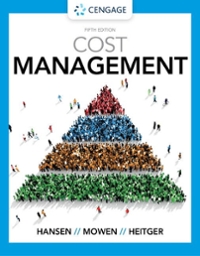A consulting firm has recently installed a TDABC system for the Shawnee University Library. The consulting firm
Question:
A consulting firm has recently installed a TDABC system for the Shawnee University Library. The consulting firm identified four major processes or departments for the library: Acquisition, Cataloging, Circulation, and Document Delivery. The Acquisition Department is responsible for acquiring new books and new journal subscriptions. Information for the Acquisition Department is given as follows:

Periodically, the library is notified of new books and journals by publishers. The Acquisition Department reviews the publishers’ list to see if any items are already in the library’s collection and also checks the demand for particular books or journals. After this selection process is complete, a list of potential acquisitions is sent to the professors of the university. Professors respond by sending a request for books or journals to the Acquisition Department. These requests are filtered, processed, and transferred to the person responsible for placing orders. When an invoice is received, it is compared with the order and payment is arranged. When the product is received, the product is verified and the requesting person is informed.
In the Acquisition Department, there are two full-time librarians and several student employees that provide 4,500 total labor hours (practical capacity). In addition, there are 500 machine hours used in the acquisition process (also at practical capacity). Thus, the total practical capacity of the Acquisition Department is 5,000 hours or 300,000 minutes per year.
The library orders 5,000 new books per year and acquires 500 new journal subscriptions.
1. Calculate the capacity cost rate for the Acquisition Department of the Shawnee University Library.
2. Using the capacity rate, determine the activity rates for each activity.
3. Using the activity rates, calculate the cost per unit for acquiring books and journals. What is the cost of unused capacity?
4. Prepare a time equation for acquiring books and one for acquiring journals. Using the time equations, calculate the unit costs for acquiring books and journals.
5. Suppose that some professors respond with a request for a book or journal that is not on the list provided by the library. In such cases, it takes an additional two minutes to read and reply. How would you modify the time equations in Requirement 4 to deal with this additional complexity? What will be the unit cost for books if out of the 6,000 requests for books, 500 are for books not on the list provided? Identify the data analytic type (descriptive, diagnostic, predictive, or prescriptive) that will help the library answer these questions. Note: More than one analytic type might apply.
Step by Step Answer:

Cost Management
ISBN: 978-0357141090
5th Edition
Authors: Don R Hansen, Maryanne M Mowen, Dan L Heitger





